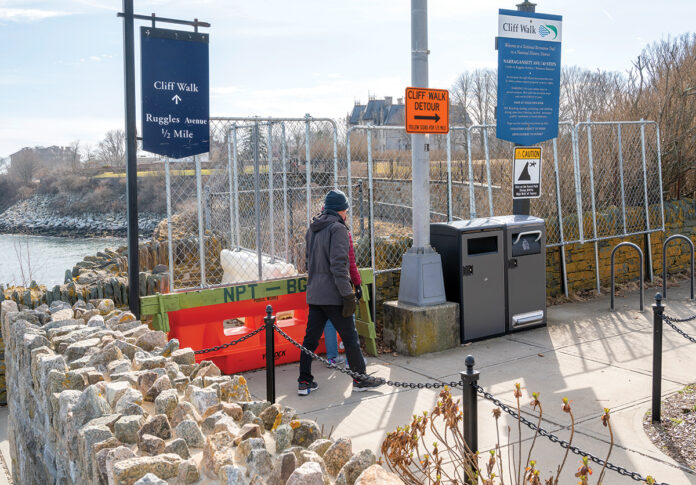Just over a year ago, the collapse of an approximately 20-foot portion of the Newport Cliff Walk raised alarm throughout the state.
Damage to Newport’s famed tourist attraction isn’t anything new – in 2012, for example, a washout from Hurricane Sandy forced the city to close more than half of the 3½-mile oceanside walkway for more than a year. And before the March 2022 collapse, a class led by Salve Regina University business and economics lecturer Samuel Sacco was already in the process of applying for a grant to fund an assessment and repairs to the Cliff Walk.
And now, grants that the class was seeking from sources such as the van Beuren Charitable Foundation Inc. were even more urgently required. While a 2012 federal disaster declaration made the city eligible for relief funding to use toward the repairs after Hurricane Sandy, no emergency resources were on the way after the damage last year. And over the winter, strong storms caused even more damage to the walkway.
For more than a year, a section of the historic Cliff Walk between Narragansett Avenue – where the well-known 40 steps to the waterline are located – and Webster Street has been closed. Visitors instead detour through the nearby neighborhood before reconnecting with the walk farther south.
The city is pushing ahead for its restoration: Within a month of the partial collapse, Newport officials hired Providence-based GZA GeoEnvironmental Inc. construction management group to carry out a study to assess the Cliff Walk’s latest damage and propose potential repairs.
That study, which concluded over the winter, is set to finalize in the coming weeks.
Not everyone thinks spending money to restore the damaged section of the Cliff Walk is the wisest idea, including Jon Nelson, a professor of environmental studies and sociology at the Rhode Island School of Design.
“There’s a symbolic aspect,” said Nelson, whose research focuses on adaptation to climate change and sustainable development. “It’s not really the dollars and cents. The decision that Newport really wants to repair it doesn’t seem to be an economic argument.
“It seems to be this mentality of not backing down, not retreating, sort of standing strong in the face of nature,” he continued, “which is ultimately a losing proposition.”
That doesn’t mean the Cliff Walk can’t exist in some form in the face of climate change, Nelson says. But he can’t envision its long-term life looking much like its current form as sea levels rise.
The city of Newport could hypothetically pursue possibilities such as buying a setback of the private property abutting the Cliff Walk to use as a green buffer space between the walkway itself and the ocean. But Nelson doubts the city has the funding for such a purchase, or that property owners would be willing to part with the land.
For decades, the Cliff Walk has been a major attraction for visitors to Newport, providing a free scenic view of both the ocean and some of the Newport mansions. One Salve study concluded more than 1 million people walk on the Cliff Walk each year.
City officials recognize the damage of the Cliff Walk is a complicated situation and a burden that Newport isn’t financially capable of bearing alone.
“It’s a really interesting piece of property in that it is a right of way across public, private and nonprofit properties that exist,” said Newport spokesperson Thomas Shevlin. “It kind of predates any land records we have in the city.”
These qualities make the Cliff Walk “well beyond any one organization’s ability to maintain it,” Shevlin said, adding that “from a holistic standpoint, it’s impossible for us to be able to look to state and federal resources to make sure the walk in its entirety remains opened and passable.”
Property owners along the Cliff Walk are responsible for some repairs to the structure, Shevlin says, and resources from Salve, such as the grant application, which was submitted over the winter and now awaits approval, also provide additional relief.
As to whether these combined efforts will amount to anything, for Nelson, the significant damage reoccurring just over a decade after Hurricane Sandy’s blow is also an omen for the famed walkway’s future.
“The part that fell was one of the last pieces to be repaired after Sandy, so it survived not even 10 years,” Nelson said.
“This isn’t abstract, 30 or 50 years into the future,” he said. “This is something that’s accelerating rapidly. And as storms get stronger and seas get higher, there’s going to be a rapid increase in the amount of deterioration these exposed areas like the Cliff Walk are facing.”
Sacco has heard the opinion that the Cliff Walk may be a lost cause. And while he doesn’t dismiss the severity of the threat it faces, he’s not convinced that the city, or the state, should give up on the local landmark.
“I think it would be a terrible shame and an incredible loss if the Cliff Walk were to go away or have its use limited,” Sacco said. “It’s very unique, and it’s one of the top natural resources we have in the state.”














We absolutely can and should repair the Cliff Walks. It is entirely possible to engineer a solution that makes the cliff walks resistant to climate change. Anyone who has gone and walked the Cliff Walks can tell you that it is economically important to Newport and Rhode Island and gives the City and our region a unique sense of place. There will always be naysayers who bring up climate change regardless of the issue at hand. It’s a false dilemma. If our local and state governments are willing to let the Cliff Walks fail due to fears of climate change that can be addressed through engineering, why should we even rebuild anything at all – why not just give up? Retreating in the face of challenges that are addressable, is a new type of nihilism. I don’t think the public is willing to give up so easy. Engineers know how to design seawalls and retaining walls. As for economics, sometimes the only reason my wife and I go to Newport is to go for a walk at the Cliff Walk or Sachuest Wild Life Sanctuary. Afterward, we also decide to stick around Newport for dinner. Let’s not overthink this issue.